 ?Mathematical formulae have been encoded as MathML and are displayed in this HTML version using MathJax in order to improve their display. Uncheck the box to turn MathJax off. This feature requires Javascript. Click on a formula to zoom.
?Mathematical formulae have been encoded as MathML and are displayed in this HTML version using MathJax in order to improve their display. Uncheck the box to turn MathJax off. This feature requires Javascript. Click on a formula to zoom.Abstract
In this paper, we investigate a class of non-invertible piecewise isometries on the upper half-plane known as Translated Cone Exchanges. These maps include a simple interval exchange on a boundary we call the baseline. We provide a geometric construction for the first return map to a neighbourhood of the vertex of the middle cone for a large class of parameters, then we show a recurrence in the first return map tied to Diophantine properties of the parameters, and subsequently prove the infinite renormalizability of the first return map for these parameters.
1. Introduction
Piecewise isometries (PWIs) are a class of maps that can be generally described as a ‘cutting-and-shuffling’ action of a metric space, specifically a partitioning of the phase space into at most countably many convex pieces called atoms, which are each moved according to an isometry. The phase space of these maps can be partitioned into two (or three) subsets based on the dynamics – a polygon or disc packing of periodic islands known as the regular set, and its complement, the set of points whose orbit either lands on, or accumulates on, the discontinuity set. Some authors choose to further distinguish those points in the pre-images of the discontinuity and those points which accumulate on it. The most well-known and well-understood examples of such maps are the interval exchange transformations (IETs), which arise as return maps to cross-sections of some measured foliations [Citation20] and also as generalizations of circle rotations [Citation7, Citation19, Citation28] and their encoding spaces generalise Sturmian shifts [Citation12]. Furthermore, interval exchanges which aren't irrational rotations are known to be almost always weakly mixing [Citation5] but never strongly mixing [Citation16]. Piecewise isometries in general, however, are not as well-known and as a subset of this class, interval exchanges are in many ways exceptional, due in part to being one-dimensional, as well as the invariance of Lebesgue measure.
In the more general setting, although the inherent lack of hyperbolicity restricts the variety of possible behaviours, for example it is known that all piecewise isometries have zero topological entropy [Citation8], piecewise isometries are still capable of quite complex behaviour; many examples show the presence of unbounded periodicity and an underlying renormalizability which structures the dynamics near the discontinuities [Citation1–3, Citation13, Citation14, Citation17, Citation24]; numerical evidence suggests the existence of invariant curves in the exceptional set which seem fractal-like and form barriers to ergodicity [Citation2–4, Citation18]; there are conjectured conditions for piecewise isometries to have sensitive dependence on initial conditions [Citation15].
Renormalization in theoretical physics and nonlinear dynamical systems has a longstanding history, see for example [Citation9–11, Citation21, Citation25–27], driven by the problem of understanding phenomena that occur simultaneously at many spatial and temporal scales, particularly near phase transitions, periodic points, or in the case of piecewise isometries, the set of discontinuities.
In this paper, we investigate the renormalizability of a class of piecewise isometries called Translated Cone Exchanges on the closure of the upper half-plane . This family of maps was introduced in [Citation4] and has since been investigated in [Citation22, Citation23]. In particular, we use a geometric construction to describe the action of a first return map to a subset containing the origin, and show that this map displays renormalizable behaviour locally to the origin in accordance with Diophantine approximation of one of its parameters. These results go beyond [Citation22, Citation23] in that they are much less constrained in the continued fraction expansion associated with the baseline translation.
This paper is organized as follows. In Section 2, we introduce the family of maps we will investigate, namely, Translated Cone Exchange transformations. In Section 3 we will develop some tools that will be useful in the next section. Section 4 presents the preliminary results that lead to the main result of this paper, Theorem 4.7, which gives an explicit form of renormalization for the first return maps of maps in our class to a neighbourhood of 0. Finally, in Section 5 we present an example for fixed values of the parameters.
2. Translated cone exchange transformations
Let denote the upper half plane, and let
be its closure in
, that is
A Translated Cone Exchange transformation
TCE
[Citation4] is a PWI
defined on the closed upper half plane
. For any integer d>0, let
be the set
Next, for some
, partition the interval
by subintervals
We then define the partition
as
where
and
The mapping is defined as a composition
(1)
(1) where E is a permutation of the cones
, G is a piecewise horizontal translation, and κ is a tuple of the parameters. Formally, let τ be a permutation of
, that is a bijection
, and let
When α and τ are unambiguous, we may refer to
simply as
. The map
is then defined as (Figures and )
Figure 3. The example partition from Figure after the TCE is performed. Note the overlapping of the cones in a region containing 0.
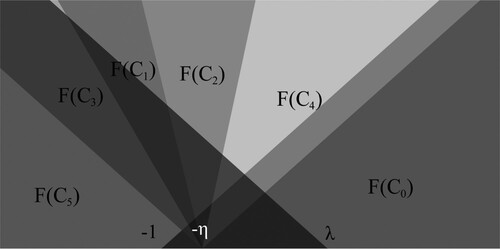
Note that E is invertible Lebesgue-almost everywhere in . We define the middle cone
of
as
The map
is defined as
(2)
(2) where
are rationally independent, i.e.
, and
. Finally, we collect the parameters into the tuple
. See Figures , and for plots of the orbit structure for
for example choices of parameters κ.
Figure 4. A plot of the first 3000 elements of the forward orbits of 1000 points (omitting the first 1500 to remove transients) chosen uniformly in the box under a TCE with parameters
,
,
,
and
. Each orbit is given a (non-unique) colour to illustrate the trajectories.
![Figure 4. A plot of the first 3000 elements of the forward orbits of 1000 points (omitting the first 1500 to remove transients) chosen uniformly in the box [−ρ,λ]×[0,1] under a TCE with parameters α=(0.5,π/7,π/4,17π/28−0.5), τ:1↦2,2↦1, λ=2/2, η=1−λ and ρ=1. Each orbit is given a (non-unique) colour to illustrate the trajectories.](/cms/asset/250432cc-c139-496a-8e51-3db716d5bbe7/cdss_a_2378297_f0004_oc.jpg)
Figure 5. A similar plot to Figure , this time of the first 3000 elements (excluding the first 1500 for transients) of the forward orbits of 1500 points chosen uniformly in the box under a TCE with parameters
,
,
, and
. Note that the phase space is very sparse compared to Figures and .
![Figure 5. A similar plot to Figure 4, this time of the first 3000 elements (excluding the first 1500 for transients) of the forward orbits of 1500 points chosen uniformly in the box [−ρ,λ]×[0,1] under a TCE with parameters α=(π/2+0.1,π/8,0.2,π/5−0.1,7π/40−0.2), τ:1↦3,2↦2,3↦1, λ=π/4, and η=1−λ. Note that the phase space is very sparse compared to Figures 4 and 9.](/cms/asset/4bdbf056-de40-461e-b79d-ed7267328ac3/cdss_a_2378297_f0005_oc.jpg)
For a>0, let denote the TCE with parameters
. Define
as uniform scaling by a about the origin
(3)
(3)
Proposition 2.1
We have the following conjugacy:
(4)
(4)
Proof.
Firstly, observe that for all ,
from which we can deduce that
(5)
(5) Let
. From (Equation3
(3)
(3) ), we get
and by expanding
as in (Equation1
(1)
(1) ), we have
Recalling (Equation5
(5)
(5) ), distributing the multiplication by 1/a, we finally see that
Clearly from this proposition, we can normalize without any loss of generality. Indeed, normalizing in this way proves very helpful for establishing recurrence results, as we shall see.
Simulations of the orbits of points under some TCEs appears to reveal complex behaviour even at small scales close to the real line, such as in Figures and . One way to investigate this behaviour is by applying the tools of renormalization. In particular, let denote the first return time of
to
under
, that is
(6)
(6) The first return map
of
to
is then defined as
(7)
(7) Observe that for all
,
, since E is the identity outside of
.
We will now state the main theorem of our paper in a simplified form, which we shall restate in more detail later as Theorem 4.7, after establishing some terminology and preliminary results.
Theorem 2.2
Let ,
be a bijection,
,
for some
and set
. Then there exist
,
of the form
for some
, and a convex, positive area set
containing 0 such that
for all
, where
.
3. Tools
In this section we prove some preliminary results that will serve as tools for more detailed investigation of the renormalization of TCEs. Firstly, we note the following smaller observations.
Proposition 3.1
Let be as in (Equation1
(1)
(1) ) and G as in (Equation2
(2)
(2) ). Then for all
,
Proof.
This is clear from the observation that E is the identity on .
Proposition 3.2
The dynamics of on
and on
are separate in the sense that
and
.
Proof.
The statement is clear from Proposition 3.1 and the fact that G is a horizontal translation.
We now prove that . Suppose that
such that
. Then
, as G is a horizontal translation. If
then
, which is a contradiction. On the other hand, if
, then
But
, meaning that
implies
. But this is only the case if
, which is a contradiction.
Let denote the itinerary for
, defined by
where
This map is similar to, but distinct from the true notion of the encoding map, since here we do not distinguish between the cones
,
,…,
within the middle cone
. The next Lemma provides a crucial tool in the proof of Theorem 4.5, since the dynamics on the interval
is that of a rotation of the circle (except at the point 0, in which case
), which is more easily understood than that of an arbitrary point in
.
Lemma 3.3
Let ,
be a bijection,
such that
, and
. If
, then for all
,
Proof.
Suppose not, for a contradiction. Then there is some n with such that
, and without loss of generality assume that n is the smallest such integer. Clearly n>1, so for all
,
, and therefore
for all
, but
. Since
, we cannot have
for all
. Hence for addresses of the
th iterates of z and 0 to disagree, one of two cases must occur:
and
; or
and
.
Since the orbit of 0 is restricted to and since
, the second parts of each case become
and
, respectively.
Suppose , and let
and
. Then
if and only if
. Note that since G is a horizontal translation,
if and only if
. Similarly
if and only if
. The two above cases above can thus be reformulated as:
and
; or
and
.
In case 1, we get . Hence
and thus
which is a contradiction. Case 2 leads to a similar contradiction. Therefore there is no such n.
3.1. Continued fractions
Recall from the theory of continued fractions that the nth convergent to a positive, irrational real number is a fraction
, where
are coprime integers and
. The numbers
can be generated by the recursive relations:
(8)
(8) Furthermore, the convergents to λ satisfy the property that for all positive integers
and all
,
with equality only when
. Also observe that we can use the recurrence relation in (Equation8
(8)
(8) ) to set
(9)
(9) Let
denote the Gauss map, given by
In particular, if
, then
Let
. To start, let
and define the function
by
Note that
is surjective and in fact
(10)
(10) Furthermore, if we define the subset
to be
then
is a bijection.
From now on, we denote the jth coefficient of the continued fraction expansion of by
. The next proposition gives us a nice relationship between the set
and the Gauss map g.
Proposition 3.4
Let . Then
if and only if
. Moreover,
Proof.
We have that is equivalent to
. We also have that
, so
. This is equivalent to
.
If m = j = 0, then the second part of our lemma is clearly true.
Assume j = 0 and m>0. Then
where the final equality is true since
is equivalent to
.
Finally, suppose m, j>0. Then
Note that since
is equivalent to
, we have
The bijection mainly serves as a way to show that there is a ‘natural’ well-ordering for the set
, which allows us to meaningfully index sequences by
and, as we shall see later, define the notion of a maximal element of a finite subset of
.
We define the one-sided convergents (or semiconvergents) to λ as the fractions
Indeed, this formula is compatible with the indexing
in that
A standard result in the theory of continued fractions is that for
, we have
(11)
(11) One way to interpret these fractions is as being the best rational approximates of λ from one ‘direction’. In particular, borrowing notation from the beginning of Section 2.2 in [Citation23], we have
where
are the best rational approximates from above in the sense that
and for all rational numbers
such that
and
, we have
(12)
(12) and in a similar fashion
are the best rational approximates from below in the same sense except that
and
(13)
(13) holds for
such that
and
.
We define the sequence by
(14)
(14) We see immediately from the above discussion that
if and only if m is odd and n>0 or m is even and n = 0, that is
(15)
(15) By expanding the definitions of
and
, we see
(16)
(16) for
with
. Moreover, by expanding the recurrence relation for
and
and rearranging terms, we have the additional property
for
.
Note that in agreement with the function , we have
. A result by Bates et al. [Citation6] presents an interesting connection between iterates of the Gauss map and consecutive errors in the approximation of λ by its convergents.
Lemma 3.5
Theorem 10 of [Citation6]
Let . For all
,
(17)
(17)
Equation (Equation17(17)
(17) ) can be equivalently formulated as
(18)
(18)
Lemma 3.6
Let . For all
with
,
(19)
(19)
Proof.
For n = 0, , so (Equation19
(19)
(19) ) holds.
Next, observe that
Since
, this becomes
We thus see that
and by recalling
,
,
, and
from (Equation8
(8)
(8) ), we get
Using (Equation18
(18)
(18) ), we can substitute
and rearrange terms to get
Finally, from this and (Equation16
(16)
(16) ) we get (Equation19
(19)
(19) ).
Corollary 3.7
For all , where
,
, we have
(20)
(20)
Proof.
This follows from Lemma 3.6 with instead of λ.
Our next Lemma is an important tool for determining scaling properties of these errors.
Lemma 3.8
Let . For all
such that
and
,
(21)
(21)
Proof.
Let us prove first that (Equation21(21)
(21) ) holds for n = 0. By multiplying and dividing by
for all
, we get
Then, using (Equation18
(18)
(18) ), we get
Rearranging this last expression and using (Equation20
(20)
(20) ), we get
We then simplify the product by cancelling terms in the numerator and denominator to get
Finally, for general
,
,
, we have
Using (Equation19
(19)
(19) ) and (Equation21
(21)
(21) ) for n = 0, we get
and then using (Equation20
(20)
(20) ) gives us
as required.
With these properties in mind, we will now define the sets which will partition a neighbourhood of the middle cone . Recall that
denotes the subset of
defined by
For
, let
be the set defined by
(22)
(22) For brevity, we will drop the argument λ from
if it is unambiguous. Additionally for the purposes of the case that m = 0, and recalling (Equation9
(9)
(9) ), we have
Recall from (Equation15
(15)
(15) ) that for
,
if and only if m is odd and n>0 or m is even and n = 0. Thus we can clearly see that
for all
. Additionally, since every point in
has positive imaginary part, the boundary of
consists of segments of the non-horizontal boundary lines of
,
, and
, and all of these lines either have angle
or
. Thus,
is a quadrilateral, and its opposing sides must be parallel, so it is a parallelogram.
Indeed, since opposite edges of are parallel, the side lengths of
are uniquely determined by the horizontal distances between opposing edges. In the case that m is even, these are precisely the distances between the vertices of the pairs of cones
and
, and
and
. In the case that m is odd, the horizontal distances are determined by the distance between the vertices of pairs of cones
and
, and
and
. Since
, we know that these distances are equal. Therefore, the side lengths of opposing edges of
are equal and can be calculated as
(23)
(23) These sidelengths are equal only when
, in which case
is a rhombus for all
. See Figure for an example of the geometry of the construction of sets
.
Figure 6. An illustration of the construction of the parallelogram for the parameters in Figure . Here, the angles shown indicate the cones used to construct
. In this case, the vertices of these cones can be verified via (Equation22
(22)
(22) ) to be
,
, 0 and
.
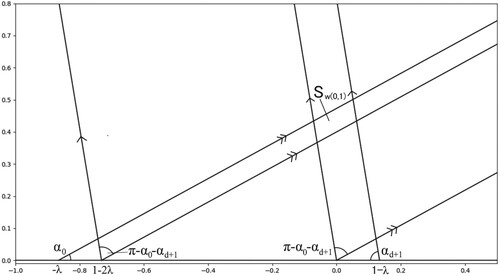
An interesting property of these sets can be found by an application of Lemma 3.8.
Theorem 3.9
Let . For all
such that
and
is even,
Proof.
Firstly, recall from (Equation15(15)
(15) ) that since m is even,
, and thus
Hence,
for all
and all
. Thus, we have
Using (Equation21
(21)
(21) ) many times give us
Finally, comparing this with (Equation22
(22)
(22) ) gets
This theorem seems to suggest the possibility of infinite renormalizability of the first return maps to for a whole class of TCEs. At the very least, if indeed the first return map of a TCE to
is an isometry on
for
with
and some
, then at the very least the partition matches with its potential renormalization (Figures and ).
4. Renormalization around zero
In this section we investigate renormalizability of TCEs around the origin for a broad range of values of λ and η.
Let and
such that
for some
. Note that
has a well-ordering
induced by the indexing function
so that
Thus, the notion of a ‘maximal element’ of a finite subset of
is well-defined.
Let be the largest element of
such that
(24)
(24) The pair
is well-defined since
but
. Thus,
.
Note that for all ,
Define the sequence
of positive integers by
(25)
(25) We can establish some recurrence relations for the sequence
using those of
and
.
Proposition 4.1
Let . Then
Moreover, if
, then
.
Proof.
Recall from the definition of and
in (Equation11
(11)
(11) ) that
and
By applying this to the formula (Equation25
(25)
(25) ), we get
Recalling the formula (Equation25
(25)
(25) ) for
, we get
Recall that
is the largest pair in
such that either
or
. Thus, if
, then necessarily
and
, which further implies
by (Equation25
(25)
(25) ).
We won't attempt to find recursive relations for all iterates of at 0, but we will at least calculate the orbit of 0 at iterates given by the sequence
.
Lemma 4.2
Let such that
. Then
Proof.
Suppose, for a contradiction, that . Let
and
denote the sequences defined by
(26)
(26) Note that since
, we have
which is never equal to 0 since λ is irrational and
and
are both positive. Observe that
and
are both non-decreasing and obey the following rule:
Given that
, we can deduce that the sequences
and
achieve every non-negative integer value, that is, for any
, there is some
such that
, and similarly there is some
such that
. Moreover, a simple inductive argument shows that for all integers
,
Next, observe that
is equivalent to the statement that
and
. However, notice that
This implies one of two cases.
and
; or
and
.
Suppose case (1) holds. Since is non-decreasing and takes every non-negative integer value, we know that there is some non-negative integer
such that
. Thus,
Note that
. Now, suppose
. Then for any
, we have
Thus,
for
. In particular,
But then
And this implies that
But this contradicts our assumption that
.
Now suppose that . Let
. Then either
or
. But
implies
and
. This contradicts the ‘best approximate’ property of the semiconvergent
. Thus
for all
. Thus, by a similar argument to before, we reach the contradiction that
.
In case (2), and
. We can reach a similar contradiction as above, by using a similar argument where the roles of
and
are interchanged.
This exhausts all cases, so our assumption that must be false.
Lemma 4.3
Let such that
. Then, for all
,
Proof.
recall that , for some
. Since
and
are non-decreasing and
, we have that
and
, not both equal. Hence either
or
and
. In either case, by the best approximate property of convergents
Lemma 4.4
Let . Then for all
,
Proof.
From (Equation12(12)
(12) ), recall that if m is even and n>0, then
is a best approximate from above, which implies
(27)
(27) for all
with
such that
.
Let and
be the sequences described by (Equation26
(26)
(26) ). Suppose that
with
. Then
since
and
are non-decreasing. Thus,
(28)
(28) not both equal. Therefore, from (Equation26
(26)
(26) ) we know that
and by (Equation27
(27)
(27) ) with (Equation28
(28)
(28) ), we have
Recalling the definition of
as in (Equation14
(14)
(14) ), we get
Finally, by using (Equation16
(16)
(16) ), we have
If
, then by Lemma 4.3, we have
From (Equation13
(13)
(13) ), recall that if m is odd and n>0, then
is a best approximate from below, that is
for all
with
such that
. Thus, in the case that m is odd and
, then
not both equal. Thus, similarly to the above case where m is even, we have
On the other hand, if
, then by Lemma 4.3,
In order to prove the next theorem, we will distinguish between the following two cases and we will prove them separately. We will first prove that
and then we will prove that
Theorem 4.5
Let ,
be a bijection,
,
for some
and set
. For all
with
,
exists and is equal to
. Moreover, let
. Then
(29)
(29)
Proof.
Let . Assume
. Observe that
, so
. By Lemma 3.3, we know that
Suppose, for a contradiction, that
. We will prove the contradiction for even and odd m separately, starting with the case that m is even. By Lemma 4.4, we know that either
or
. Since m is even, recall that
Observe that
Therefore, if
, then
But by the definition of
as in (Equation6
(6)
(6) ), we have
which reveals a contradiction. Similarly, if
, then
which also contradicts
.
Now suppose m is odd. Then
By Lemma 4.4, we know that either
Clearly, either of these cases give similar contradictions as before. Therefore our assumption that
must be false, so in fact
.
Now, suppose . By Lemma 3.3,
and by Lemma 4.2 we know that
Combining these two with our assumption gives us that if
then
.
With this Theorem, as well as Theorem 3.9, we can prove the existence of a renormalization scheme around the point 0. First, we will find the definition of the first return map on the rest of
.
Lemma 4.6
Let be as in (Equation22
(22)
(22) ) and
as in (Equation24
(24)
(24) ). Define the set
Then
and
is convex.
Proof.
For brevity we will drop the parameters κ when they are unambiguous. We will first prove the equality
Observe that for all
,
Additionally, if
such that
, then
Note that
for all
. Thus, we have
We also know that
Thus, with a similar argument as above, we can show that
Altogether, we deduce that
Suppose
is even, and let
with
. Then there is some
with m is odd and
such that
and there is some
with
even and
such that
Suppose that
and
are the largest such pairs, which is well-defined since
. Since m is odd and
is even, we either have
or
. Suppose
. Then
Since
is the largest pair such that
, and noting that
since n + 1>0, we have that
However,
since m is odd and so
. Importantly,
and thus
. Therefore,
so clearly
. In the case that
we can use a similar argument to prove that
so that
. If
is odd and
with
, then we can use a similar argument to prove that
. Hence, we have
To show that U is convex, one must note that the cones
,
, and
and all their translates are convex sets, and that the intersection of convex sets is also convex.
Define
(30)
(30) for
(omitting the arguments where unambiguous), and let
where
is such that
and
. If
is the maximal element of
such that
or
, then
. Furthermore,
(31)
(31) Given
,
be a bijection,
,
,
for some
, let
be as in (Equation24
(24)
(24) ). Let
be defined by
and let
(32)
(32) Clearly by the definition of the one-sided convergents in (Equation11
(11)
(11) ), we have
With this in mind, we have the following Theorem.
Theorem 4.7
Let ,
be a bijection,
and
for some
. Set the tuples
and
, where
and
is as in (Equation32
(32)
(32) ). Then for all
,
Proof.
We begin by noting that the quantity
(33)
(33) satisfies
and, importantly for the reasons of (Equation31
(31)
(31) ), we have
(34)
(34) Here we recall the equality in Proposition 3.4 since
is being considered an element of
and
an element of
.
Recall that by Theorem 3.9, we have
for all
with
, i.e.
. Note that by Proposition 3.4,
is equivalent to the statement that
Hence,
Let
so that
with
. Also note that since
for all a>0 and E consists of rotations about 0, we have
(35)
(35) for a>0. Therefore
and by expanding
as in (Equation29
(29)
(29) ) we get
Using Equation35
(35)
(35) , we get
Now, recall that
and
, so that
. Using (Equation21
(21)
(21) ) and comparing with the formula for
as in (Equation29
(29)
(29) ), we see
The immediate consequence of Theorem 4.7 is that when and
, one can renormalize infinitely ‘towards’ 0 in the sense that the domains of each renormalization are shrinking neighbourhoods of 0 in
. Additionally, the renormalizations are determined by the orbit of λ under the square of the Gauss map
. We shall now apply our results in this and the previous section to an example (Figure ).
5. An example
As an example inspired by Peres and Rodrigues [Citation23], we will set ,
,
, and
, where
(36)
(36) In this case the the space
since
and so
for all
. Thus,
. Also due to
for each
, the semiconvergents
simply coincide with the convergents
, and the convergents are in this case defined by
It is thus clear that
and
, where
is the Fibonacci sequence with
and
.
The first return times in the case of
are given by
for all
. Observe that
for all
, and
,
. Now note that
, and thus we have
The errors of the convergents
are given by
(37)
(37)
Proposition 5.1
We have
Proof.
Observe that
Recall that
and
. Then a simple inductive argument shows us that
Noting that the recurrence relations for and
give us
and
and so we can set
, which remains consistent with (Equation37
(37)
(37) ). With this proposition in mind, for
we can determine the sets
as
These are rhombi, as can be seen in Figure , and as can be deduced from the discussion around (Equation23
(23)
(23) ) since
. It is also clear to see that for all
.
(38)
(38) In this case, it is simple to find a partition for the entirity of the middle cone
for the map
. In particular, define the sets X and Y to be
(39)
(39) and
(40)
(40) As we will see soon, the collection
forms a partition of
. We are interested in the pre-image of these sets under E. In particular, define the partition
Figure 10. A partition of in the case where
,
,
,
, and
. A cascading pattern towards the origin can be seen, but its geometric structure becomes clearer after we apply the cone exchange E.
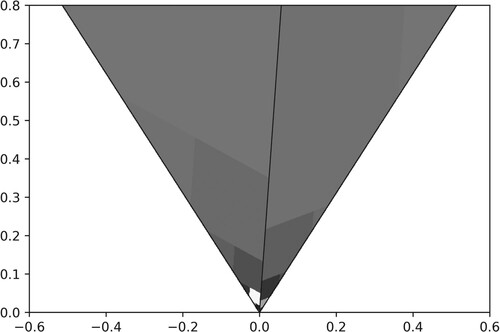
Figure 11. The same partition as in Figure , but after an application of E, which reveals an alternating pattern of rhombi.
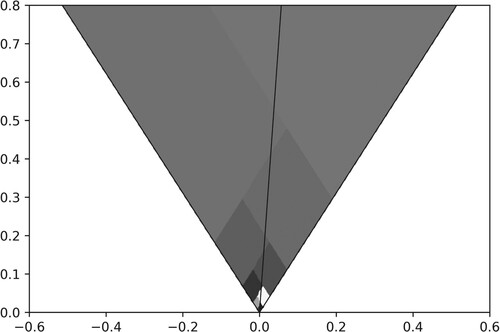
This partition can be seen in Figure . As a consequence of the next theorem, is a PWI with a countably infinite number of atoms. We also define a separate family of sets
which includes only the rhombi, and thus forms a partition of only a subset of the middle cone. Note that since
for all
and
. We see that the set
from Lemma 4.6 is given by
Also observe that by removing
and
we get
From this, we notice that
but since
, we know that
, so
Therefore, we can see that
and a similar argument tells us that
and so finally we get,
Therefore,
is a partition of
up to a set of Lebesgue measure 0.
Note that for all ,
, and so by recalling that
, the condition that
is equivalent to the condition that
which is itself equivalent to
With this in mind, Theorem 4.5 tells us that for all
, if
, then (Figure )
and
Figure 12. The same partition of as in Figure , after an application of
, which has shifted the rhombi alternately. Note that there is an overlap between the cone and ribbon (both of which are more clearly seen in Figure ) on the top of the figure, causing an unavoidable overlap of the colours.
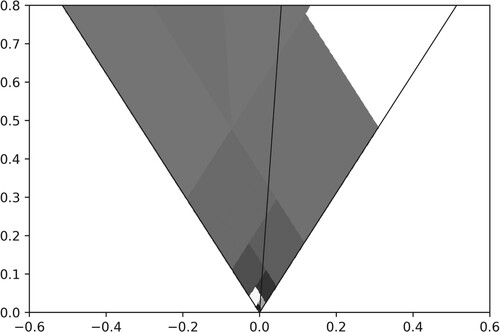
Observe that is a special case of irrational number within
in the sense that it is a fixed point of the Gauss map g. Thus,
and thus we can choose
and Theorem 4.7 tells us that the first return map
exhibits exact self-similarity within
. In particular, for all
, we have the following conjugacy
One consequence of this is that if there exists a periodic point
of period k, then z is a periodic point of
with period
. The self-similarity shows that for all
such that
,
is a periodic point of
, thus also a periodic point of
whose period is an integer multiple of
. In particular, there is a sequence
given by
(41)
(41) so that for all
,
and the period of
is an integer multiple of
, where
.
Given a map , let
denote the forward orbit of
under f, that is
Proposition 5.2
Suppose there exists a periodic point for some
, and let
be the sequence of periodic points given by (Equation41
(41)
(41) ). Then the sequence
of periodic orbits accumulates on the interval
.
Proof.
Let . Note that
(42)
(42) Lemma 3.3 tells us that for all
,
Therefore,
(43)
(43) Let
. Then there exists an
such that
for all
, and thus (Equation43
(43)
(43) ) holds for all
. Now let
be small. Then there exists an
such that for all integers
such that
(44)
(44) Set
. Then for all integers
, both (Equation43
(43)
(43) ) holds for all
and (Equation44
(44)
(44) ) holds. Hence, for all
we have
for all
. Since H and ε are independent and arbitrary, we conclude that the sequence
accumulates on the set
.
By Proposition 3.1, is a 2-IET everywhere on the interval
except on the preimages of 0, since
, contrary to
for
and
for
.
Therefore is conjugate to an irrational rotation almost everywhere (with respect to one-dimensional Lebesgue measure), since
is irrational. In particular, since λ is irrational and
, we know, by for example Lemma 4.3, that
is bounded away from 0 for all integers j>0, so
for any j>0.
Hence, the orbit of under
is also the orbit under an irrational rotation, and thus the orbit of 0 is dense in the interval
, i.e.
Therefore, the sequence
accumulates on the interval
.
Remark 5.3
Although extending Proposition 5.2 to periodic continued fractions λ should follow from a similar strategy to the proof used here, an extension to aperiodic continued fractions seems to require nothing short of assuming/proving that every TCE has at least one periodic point in its ‘renormalizable domain’ .
6. Discussion
Translated cone exchanges, introduced first in [Citation4] and investigated in [Citation22, Citation23], are an interesting and largely unexplored family of parametrized PWIs. They contain an embedding of a simple IET on the baseline and as such they are an interesting tool to understand more general PWIs by gaining leverage from known results for IETs. In this paper we go beyond results in [Citation4, Citation22, Citation23] to show that for a dense subset of an open set in the parameter space of TCEs there is a mapping ( in Theorem 4.7) that determines a renormalization scheme for the first return map
of
to the vertex 0 of the middle cone
. This helps us describe the small-scale, long-term behaviour of
near the baseline
via the large-scale, short-term behaviour of
with
,
, a large enough integer k>0 and some suitably chosen
described by (Equation32
(32)
(32) ). Proposition 5.2 is an example of this, where a periodic disk of small period for
and the periodicity of the continued fraction coefficients of
give rise to an countable collection of periodic disks of arbitrarily high period clustering on
, through the renormalizability established by Theorem 4.7.
Although these results give a glimpse into the dynamics for orbits close to the baseline, there remains a lot more to do to understand the dynamics of these TCEs near general points in exceptional set, but this seems to be a far more complex task to undertake, especially as the dynamics near the baseline primarily consists of horizontal translations, whereas in general the effect of the rotations will be inextricably linked to translations.
diff.pdf
Download PDF (1.9 MB)Acknowledgments
We thank Pedro Peres and Arek Goetz for discussions about this research. NC and PA thank the Mittag-Leffler Institute for their hospitality and support to visit during the ‘Two Dimensional Maps’ programme of early 2023.
Disclosure statement
No potential conflict of interest was reported by the author(s).
Data availability statement
For the purpose of open access, the authors have applied a Creative Commons Attribution (CC BY) licence to any Author Accepted Manuscript version arising from this submission.
No new data were generated or analysed during this study. The figures in this study were produced by python programming code written by NC. This code, namely the ‘pyTCE’ program, is publicly available at the following link: https://github.com/NoahCockram/pyTCE/tree/main.
Additional information
Funding
References
- Adler R, Kitchens B, and Tresser C, Dynamics of non-ergodic piecewise affine maps of the torus, Ergod. Theory Dyn. Syst. 21 (2001), pp. 959–999.
- Ashwin P and Goetz A, Invariant curves and explosion of periodic Islands in systems of piecewise rotations, SIAM J. Appl. Dyn. Syst. 4 (2005), pp. 437–458.
- Ashwin P and Goetz A, Polygonal invariant curves for a planar piecewise isometry, Trans. Amer. Math. Soc. 358(1) (2006), pp. 373–390.
- Ashwin P, Goetz A, Peres P, and Rodrigues A, Embeddings of interval exchange transformations into planar piecewise isometries, Ergod. Theory Dyn. Syst. 40 (2020), pp. 1153–1179.
- Avila A and Giovanni F, Weak mixing for interval exchange transformations and translation flows, Ann. Math. 165(2) (2007), pp. 637–664.
- Bates B, Bunder M, and Tognetti K, Continued fractions and the Gauss Map, Acad. Paedagog. Nyiregyhazi. Acta Math. 21 (2005), pp. 113–125.
- Boshernitzan MD and Carroll CR, An extension of Lagrange's theorem to interval exchange transformations over quadratic fields, C.R. J. Anal. Math. 72 (1997), pp. 21.44
- Buzzi J, Piecewise isometries have zero topological entropy, Ergod. Theory Dyn. Syst. 21 (2001), pp. 1371–1377.
- Coullet P and Tresser C, Itérations d'endomorphismes et groupe de renormalisation, J. Phys. Colloq. 39(C5) (1978), pp. 25–28.
- Feigenbaum MJ, Quantitative universality for a class of nonlinear transformations, J. Stat. Phys. 19 (1978), pp. 25–52.
- Feigenbaum MJ, The universal metric properties of nonlinear transformations, J. Stat. Phys. 21 (1979), pp. 669–706.
- Ferenczi S and Zamboni LQ, Languages of k-interval exchange transformations, Bull. London Math. Soc. 40(4) (2008), pp. 705–714.
- Goetz A, A self-similar example of a piecewise isometric attractor, Dyn. Syst.: Cryst. Chaos. (2000), pp. 248–258.
- Goetz A and Poggiaspalla G, Rotations by π/7, Nonlinearity 17 (2004), pp. 1787–1802.
- Kahng B, Singularities of two-dimensional invertible piecewise isometric dynamics, Chaos: Interdiscip. J. Nonlinear Sci. 19(2) (2009), pp. 023115–023115.
- Katok AB, Interval exchange transformations and some special flows are not mixing, Israel J. Math.35 (1980), pp. 301–310.
- Lowenstein JH, Kouptsov KL, and Vivaldi F, Recursive tiling and geometry of piecewise rotations by π/7, Nonlinearity 17 (2003), pp. 371–395.
- Lynn TF, Ottino JM, Umbanhowar PB, and Lueptow RM, Identifying invariant ergodic subsets and barriers to mixing by cutting and shuffling: Study in a birotated hemisphere, Phys. Rev. E 101(1) (2020), pp. 012204–012204.
- Marchese L, The Khinchin theorem for interval-exchange transformations, J. Mod. Dyn. 5(1) (2011), pp. 123–183.
- Masur H, Interval exchange transformations and measured foliations, Ann. Math. 115(1) (1982), pp. 169–200.
- McMullen CT, Complex Dynamics and Renormalization, Vol. 135, Princeton University Press, Princeton, New Jersey, 1994.
- Peres P, Renormalization in piecewise isometries, PhD thesis, University of Exeter; 2019.
- Peres P and Rodrigues A, On the dynamics of translated cone exchange transformations, 2018; preprint arXiv:1809.05496.
- Poggiaspalla G, Self-similarity in piecewise isometric systems, Dyn. Syst. 21 (2006), pp. 147–189.
- Rauzy G, Échanges d'intervalles et transformations induites, Acta Arith. 34(4) (1979), pp. 315–328.
- Veech WA, Gauss measures for transformations on the space of interval exchange maps, Ann. Math.115 (1982), pp. 201–242.
- Wilson KG, The renormalization group and critical phenomena, Rev. Mod. Phys. 55(3) (1983), pp. 583–600.
- Zorich A, Finite Gauss measure on the space of interval exchange transformation. Lyapunov exponents, Ann. Inst. Fourier, Grenoble 46 (1996), pp. 325–370.

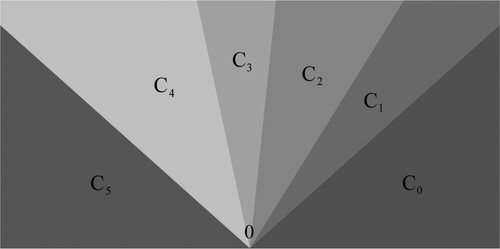

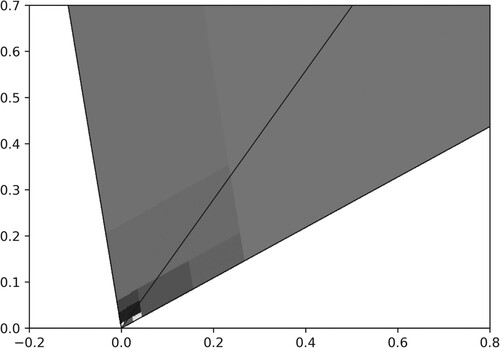
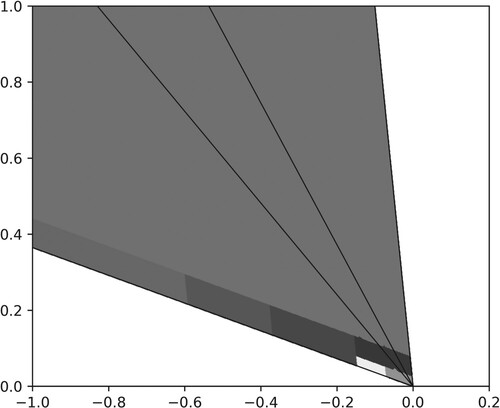
![Figure 9. A plot of 1500 iterates of 500 uniformly chosen points within the box [−1,λ]×[0,1.1] under the TCE with parameters α=(π/2−0.6,0.5,0.7,π−0.6), τ:1↦2,2↦1, λ=Φ, η=Φ2, and ρ=1. The first 400 points of each orbit are omitted to remove transients.](/cms/asset/5ccf00c1-533d-40a9-9620-faa94edc0cc5/cdss_a_2378297_f0009_oc.jpg)